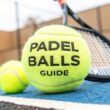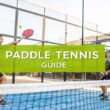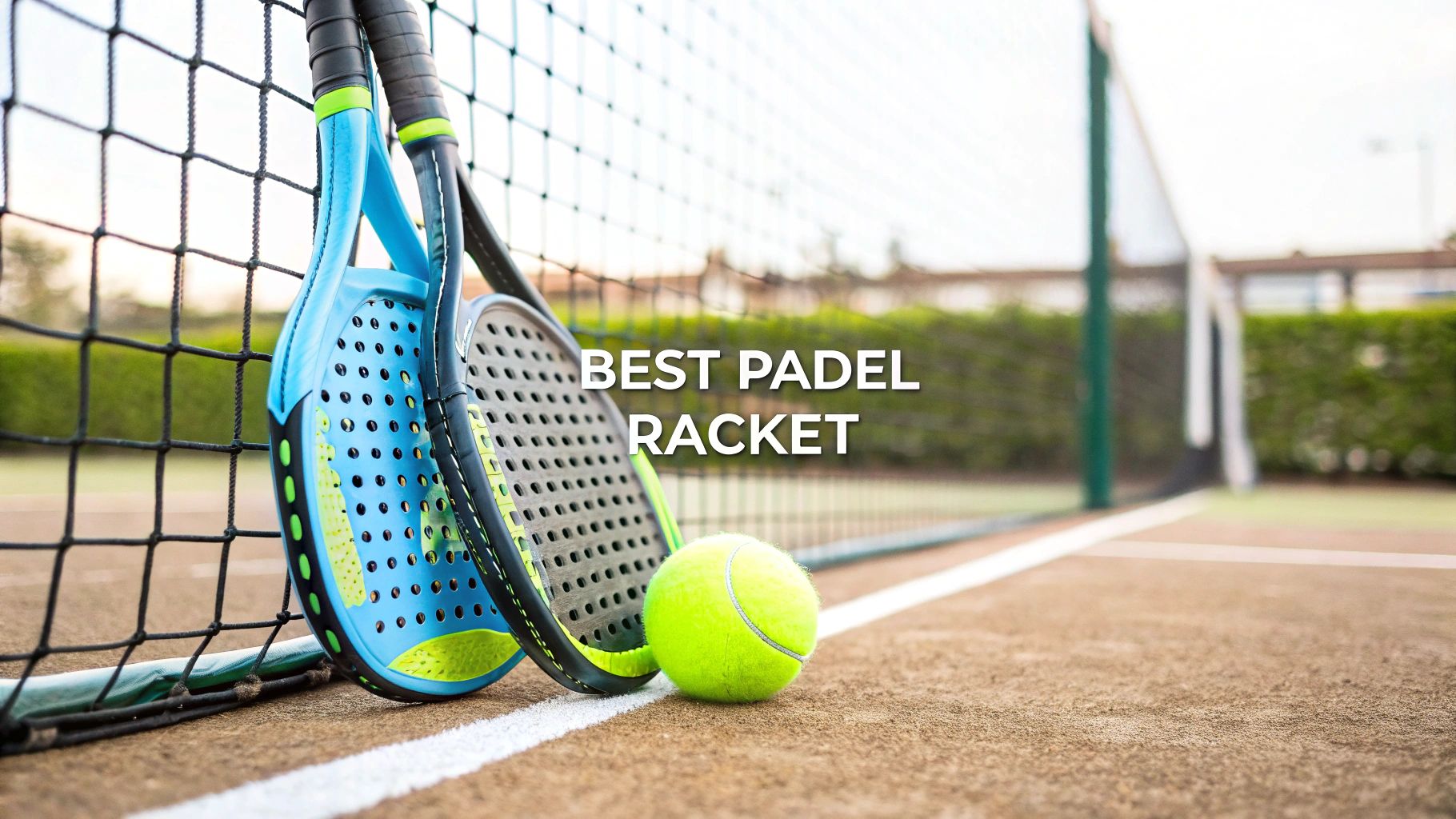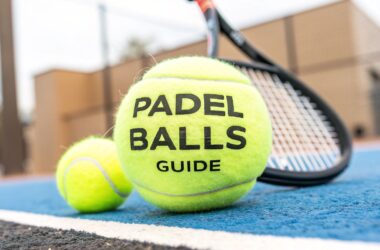When you're shopping for the best padel racket for intermediate players, you’re generally looking at a teardrop-shaped model that weighs somewhere between 360-375 grams. This specific design hits the sweet spot between power and control.
It’s the kind of racket that supports a developing game, giving you the confidence to go for aggressive smashes while still having the touch for precise, defensive shots. Finding the right fit here is a massive step in leveling up your skills on the court.
Finding the Right Racket to Advance Your Game
Making the jump from beginner to intermediate is a huge milestone in your padel journey, and it’s the perfect time to make sure your gear is keeping up. You’ve probably got the basic strokes down and are now starting to think more about tactics, adding spin, and mixing up your game with volleys, lobs, and bandejas. This is exactly where that old, generic beginner racket starts to hold you back.
An intermediate player needs a racket that gives them feedback and actually rewards better technique. Beginner rackets are all about maximizing control, while pro-level models demand near-perfect precision. The best intermediate rackets live right in the middle—they offer enough power to end a point but still have the forgiveness you need when you don't hit the ball dead center.
The real challenge for an intermediate player isn't just hitting the ball; it's about consistently placing it with intent. Your racket should be an ally in this process, not an obstacle.
It’s no surprise that the demand from players like you is making the market explode. The global padel racket market was valued at USD 130.91 million in 2024 and is expected to climb all the way to USD 469.77 million by 2034. This boom is massively driven by intermediate players looking for gear that bridges the gap from basic play to high-performance action. You can discover more insights about this trend and its impact on the padel market.
Key Intermediate Racket Specifications
Before we get into specific models, it’s a good idea to know what you're looking for under the hood. This table breaks down the core features of a great intermediate racket.
| Feature | Ideal Specification for Intermediates | Impact on Your Game |
|---|---|---|
| Shape | Teardrop | Offers the best mix of power and control for a versatile game. |
| Weight | 360g – 375g | Provides stability for powerful shots without sacrificing speed. |
| Balance | Medium (Evenly Balanced) | Supports both defensive maneuvers and attacking volleys at the net. |
| Core Foam | Medium-Density EVA or Foam | Delivers a comfortable feel with good ball output and precision. |
Think of these specs as your starting point. They represent the ideal balance for a player who has moved past the basics and is now focused on developing a more complete, all-around game.
How Racket Shape Influences Your Shots
Understanding racket geometry is a game-changer once you hit the intermediate level. You're no longer just trying to get the ball over the net; you're thinking about placement, adding power, and generating spin. The shape of your racket is a massive factor in all three because it dictates the racket's balance and where you'll find that all-important sweet spot.
A racket's shape determines where its weight is concentrated, which completely changes how it feels when you swing. Think of it this way: swinging a hammer is all about raw power, while a well-balanced sword is built for precision. This is the core concept you need to grasp to find the right tool for your game, one that can handle a wide variety of shots.
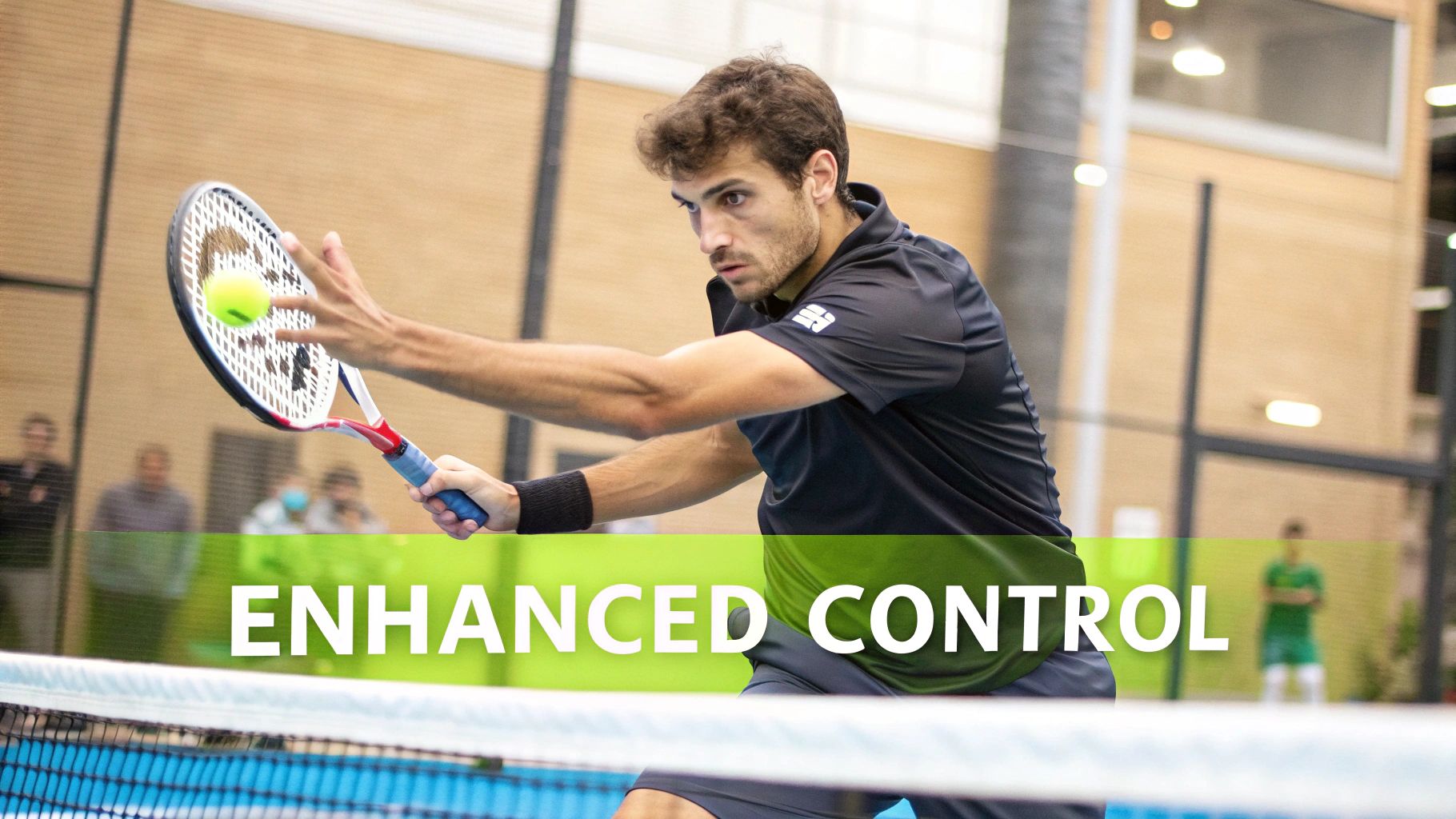
Round Rackets for Maximum Control
Round rackets are what most beginners start with, and for good reason. They have a low balance, which means the weight is closer to your hand. This makes the racket feel light and incredibly easy to handle. The design also creates a large, centered sweet spot that’s very forgiving on off-center hits.
For an intermediate player, a round racket can be a great ally if your game is built around defense and placing the ball exactly where you want it. The downside? That low balance makes it tougher to generate serious power for smashes or a heavy vibora. You get tons of control, but you might feel your attacking shots just don't have the knockout punch to end points.
Diamond Rackets for Pure Power
At the other end of the spectrum, you have the diamond-shaped rackets. These are built with a head-heavy balance, pushing all the weight to the top. This shifts the sweet spot higher up the face, making it smaller and much less forgiving, but it unleashes incredible power when you connect properly.
A diamond racket is really a specialist's tool, designed for aggressive, advanced players who have their timing dialed in perfectly. An intermediate player might struggle to manage this shape, leading to more unforced errors and even some arm fatigue from the high balance. It demands a level of precision that most of us are still working on.
The teardrop shape is the great equalizer for the intermediate player. It offers a balanced profile that doesn’t force you to choose between defending a tricky shot and attacking a weak return—it lets you do both effectively.
The Teardrop Hybrid for Versatility
Sitting right in the middle of the round and diamond shapes is the teardrop. It offers a mid-balance with a sweet spot located just a bit above the center of the face. This hybrid design gives you a fantastic blend of power and control, which is exactly why it's the most recommended shape for intermediate players.
This shape grows with you. It provides enough power to give you confidence when you go for a smash, but it still has the control you need for those delicate drop shots or deep lobs. The market clearly shows this preference; teardrop shapes are expected to capture about 36.3% of the market share for intermediate players by 2025 because they're just so well-rounded.
This versatility is key as you start to fine-tune your technique and tactical play. To see some great examples that fit this profile, check out this helpful breakdown of top rackets for intermediate players.
Matching Racket Weight and Balance to Your Style
Once you've settled on a shape, the next pieces of the puzzle are weight and balance. These two factors are completely intertwined, defining how a racket feels in your hand and behaves on the court. They influence everything from the power you can generate to your risk of injury, so getting this combo right is crucial to finding a racket that feels like an extension of your arm.
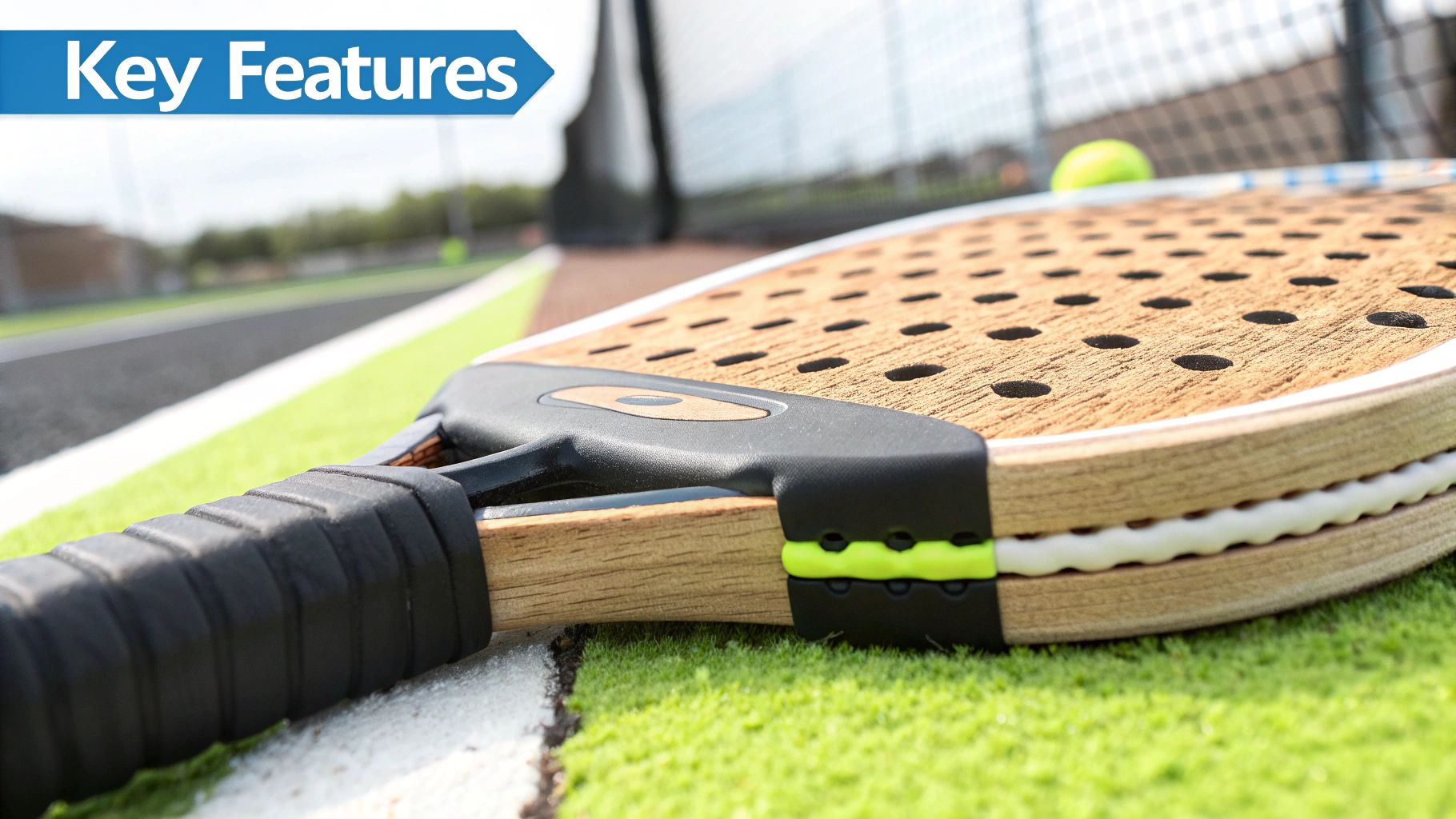
For most intermediate players, the sweet spot for racket weight is somewhere between 360 and 375 grams. This range is the perfect middle ground. It gives you enough mass for solid stability and power on your shots from the back of the court, but it's not so heavy that it kills your reaction time for those quick volleys up at the net.
A racket on the lighter end of this scale (around 360-365g) will feel zippy and easy to maneuver, letting you swing faster and make quick adjustments. On the other hand, a heavier model (370-375g) packs more punch behind the ball, which translates to heavier smashes and bandejas. Just know that it will demand more strength to wield effectively.
Finding Your Ideal Balance Point
Balance is all about how the weight is distributed along the racket. This is what truly gives the racket its personality, and there are three main types to get familiar with. Understanding how they feel in a real game is the key to choosing the best padel racket for your intermediate level.
- Head-Heavy Balance: The weight is concentrated toward the top of the racket. This creates a powerful pendulum effect, adding serious momentum and pop to your overheads. The downside? It can feel a bit unwieldy and might put extra strain on your arm.
- Even Balance: Here, the weight is distributed uniformly, offering a perfect compromise. This balance is built for an all-around game, giving you a great blend of power and control without leaning too far in either direction.
- Head-Light Balance: With more weight shifted toward the handle, these rackets feel incredibly easy to move. They're fantastic for quick defensive plays and rapid-fire exchanges at the net. The trade-off is a noticeable drop in easy, free power.
Your choice of balance directly impacts both your shot-making and your physical comfort. A head-heavy racket can give your shots a serious boost, but it might lead to tennis elbow if your technique isn't spot-on. A head-light racket is much kinder to your arm but forces you to generate more of your own pace.
The explosion in the number of intermediate players has pushed manufacturers to focus heavily on creating rackets with these moderate specs. It's estimated that in Europe, intermediate players make up a whopping 60-70% of the padel community. This has driven huge demand for rackets weighing between 360-370 grams with balanced teardrop or round shapes. You can dig deeper into the padel rackets market and its trends to see the data.
Ultimately, finding the right weight and balance is a personal journey. If you’re a defensive player who thrives on speed and placement, a lighter racket with a head-light or even balance is probably your best bet. But if you’re an aggressive player who loves to attack, a slightly heavier racket with an even or head-heavy balance will reward your style with more firepower.
Comparing Top Intermediate Padel Rackets
Okay, let's get down to brass tacks. Theory is one thing, but how these rackets actually feel and perform on the court is what really matters. To find the best padel racket for an intermediate player, you have to look past the spec sheets and see how different models handle real-game situations. It’s never about finding the single best racket, but about finding the right one for your game.
We’re going to put three different styles of racket under the microscope. Each one is designed to shine in a specific area that’s critical for players looking to level up: the balance between power and control, forgiveness on off-center hits, and all-around comfort. I’ll break down who each racket is for, helping you match the gear to your on-court goals.
The All-Court Contender
First on the list is the classic all-rounder. You'll typically find these in a teardrop shape with a medium-density core, a combination built to deliver balanced performance no matter where you are on the court. Think of it as the jack-of-all-trades, a fantastic choice for the player who's still refining their definitive playing style.
Picture yourself in a long, grinding rally, moving from deep lobs at the back to sharp volleys at the net. This racket gives you the stability you need to absorb pace on defense, but it’s still quick enough for those lightning-fast net exchanges. Its greatest strength is its adaptability. It won't give you the raw, explosive power of a diamond-shaped racket or the surgical precision of a round one, but it does everything pretty darn well.
This racket is ideal for the player mastering the 'bandeja' and 'vibora'. It offers the necessary blend of power and maneuverability to execute these complex overheads with confidence and consistency.
The Precision Specialist
Next up, we have the racket for the crafty, tactical player—the one who wins points with strategy and smart placement, not just brute force. These models often have a round shape and a softer core, which puts control and feel front and center. Their magic lies in a massive, forgiving sweet spot and incredible handling.
This is the perfect weapon for players who love to construct points with delicate ‘chiquitas’ (soft shots aimed at the opponent’s feet) and perfectly placed lobs. The enhanced feel gives you instant feedback, letting you guide the ball with uncanny accuracy. Sure, you’ll have to generate more of your own power for smashes, but the payoff is superior control that can frustrate aggressive opponents and open up the court.
To help you see how these rackets stack up, the chart below breaks down the core metrics of a few popular intermediate options.
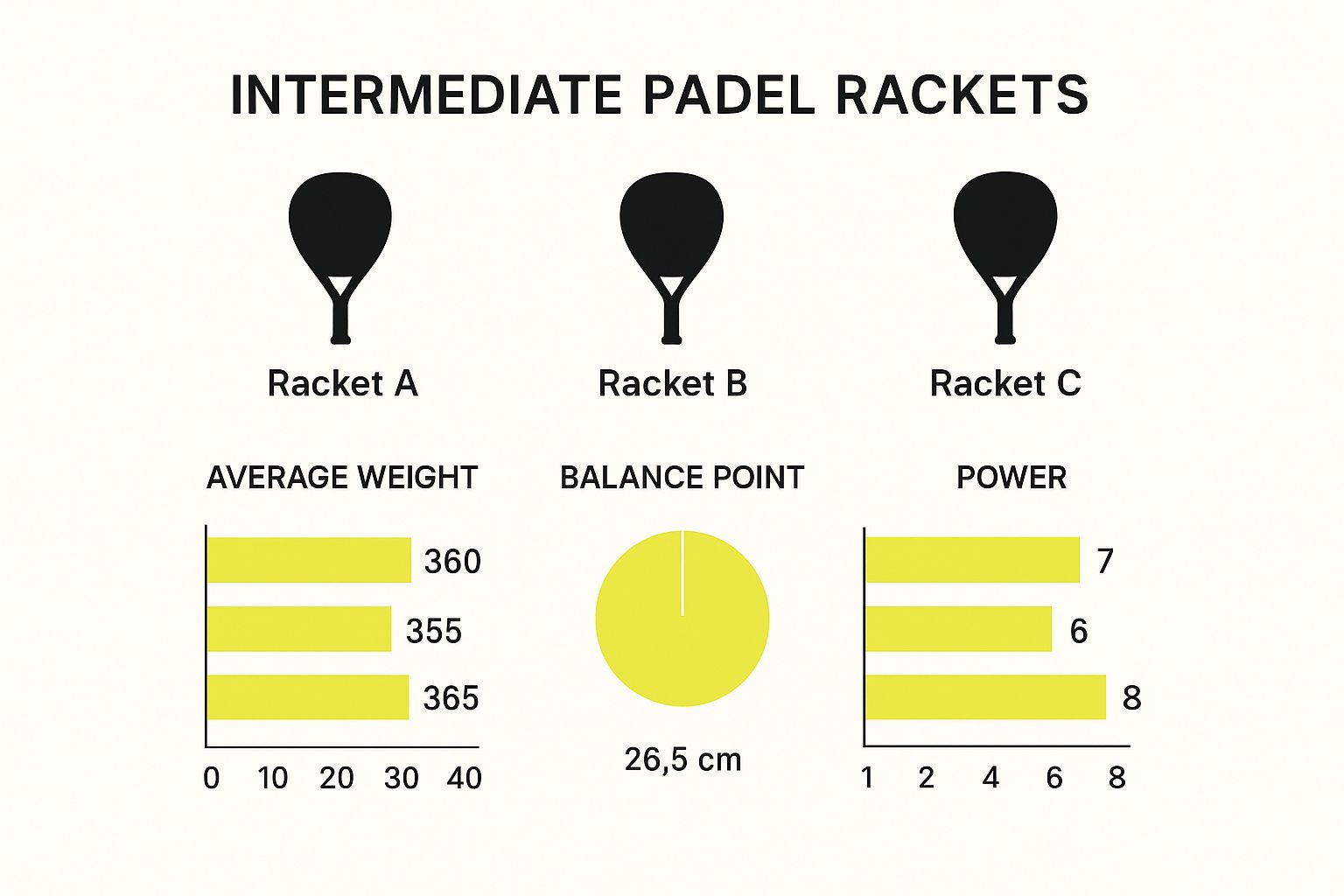
As you can see, a higher balance point usually means more power, while a lower balance gives you a racket that’s easier to control.
Intermediate Padel Racket Comparison
Here's a detailed showdown of leading intermediate rackets, evaluated on key performance metrics to help you match one to your playing style.
| Racket Model | Shape | Weight Range (g) | Core Material | Ideal Player Profile | Defining Feature |
|---|---|---|---|---|---|
| All-Court Contender | Teardrop | 360-375 | Medium EVA | The versatile player refining their game from all court positions. | Excellent balance of power and control. |
| Precision Specialist | Round | 355-370 | Soft EVA | The tactical player who prioritizes placement and feel. | Large, forgiving sweet spot and superior handling. |
| Power-Focused Hybrid | Hybrid/Diamond | 365-380 | Stiff EVA/Carbon | The aggressive player looking to dominate with powerful shots. | Extra pop on smashes and aggressive volleys. |
Ultimately, picking the right racket comes down to knowing your own game and choosing the tool that best complements your strengths.
The Power-Focused Hybrid
Last but not least, we have the aggressive hybrid. This racket leans toward a teardrop or even a hybrid diamond shape and often features a slightly stiffer face, maybe with 3K carbon fiber. It’s built for the intermediate player who already has a naturally aggressive game and wants to start finishing points with authority.
This racket comes alive in the hands of a player who isn't afraid to step in and attack the ball. It delivers that extra pop you need to hit winning smashes and drive volleys that pin your opponents to the back glass. The trade-off? A slightly smaller sweet spot and less forgiveness on mishits, so it demands better technique. But if your game is built around offense, this racket will turn your strengths into weapons.
Making the right choice really boils down to an honest look at your game. Are you an all-courter, a strategist, or an attacker? For a wider look at specific models and how they compare, you can find more great information in this detailed guide on the best padel racket options on the market. Each of these racket types offers a different path to improving your game, so pick the one that fits the player you want to become.
How to Select a Racket for Your Playing Style
Finding the best padel racket as an intermediate player isn't about grabbing the most expensive one off the shelf. It’s about finding a natural extension of your unique game. To do that, you need to be honest with yourself about how you play and, more importantly, how you win points. This goes way beyond just looking at specs on a website; it’s about understanding your identity on the court.
Are you the player who patiently defends from the back wall, grinding down your opponents until they make a mistake? Or are you always itching to rush the net and smash the point away early? Figuring out your style is the crucial first step to picking gear that plays to your strengths, not your weaknesses.
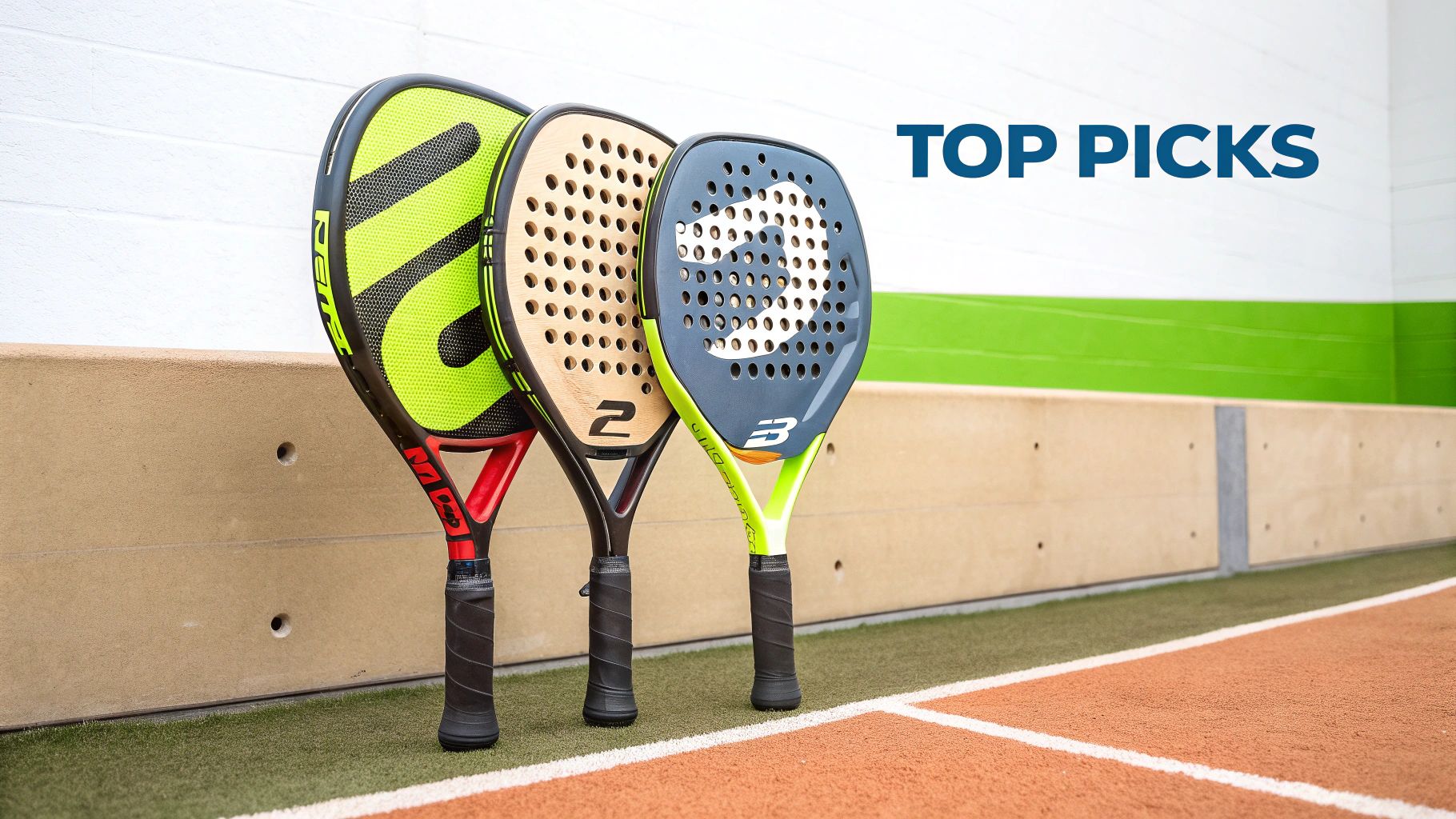
The Counter Attacker
This player lives and breathes defense and consistency. Your entire game is built around getting one more ball back, using deep lobs and tricky chiquitas to frustrate the other team and force them into errors. You win with patience and smart placement, not brute force.
If this sounds like your game plan, your ideal racket needs to prioritize control and feel.
- Racket Shape: Round. You want that big, forgiving sweet spot in the center.
- Core Material: Look for soft or medium-density EVA foam. It gives you a comfortable feel and helps the ball pop off the racket with less effort from you.
- Weight: Stick to the lighter side of the intermediate range, around 360-365g, for quicker reactions at the net and on defense.
This setup makes digging out tough defensive shots much easier and lets you place the ball exactly where you want it.
The Aggressive All Courter
You’re a threat from anywhere on the court. You’re just as happy ripping a powerful smash from the back glass as you are putting away a sharp volley at the net. Your whole strategy is to apply constant pressure and completely dictate the match's tempo.
To fuel this versatile, attacking style, you need a racket that offers a great mix of power and responsiveness.
- Racket Shape: Teardrop. It’s the perfect hybrid shape for balanced performance.
- Surface Material: Consider a carbon fiber face (3K or 6K). This gives you a crisp, powerful sensation when you connect with the ball.
- Balance: An even or slightly head-heavy balance will give your smashes and volleys that extra bit of weight.
This combination provides the firepower to finish points decisively without giving up the control you need for softer touch shots. If you want to get deeper into how different shapes fit certain styles, you might find our guide on choosing padel racket types for your game useful.
For an aggressive player, the right racket should feel like it's rewarding your attacking mindset. A slightly stiffer core, for instance, will directly translate your swing speed into ball speed, making your smashes feel significantly heavier.
The Tactical Point Builder
You play padel like a game of chess, always thinking two or three shots ahead. You're constantly mixing up your shots—using different spins, speeds, and depths—to pull your opponents apart. You win points with your brain, not just your brawn.
A tactical player needs a racket that offers incredible feel and versatility above all else.
- Racket Shape: A teardrop or a control-focused hybrid will work well.
- Surface Texture: A rough or textured face is a huge plus, as it helps you generate extra spin on your viboras and sliced shots.
- Core Material: A medium-density core is perfect here, giving you a great blend of feedback and power for whatever shot you decide to play.
With this kind of racket in your hands, it becomes a precision tool, allowing you to execute your strategies and keep the other team completely off-balance.
Common Questions on Intermediate Padel Rackets
Stepping up your game means you're probably starting to ask more questions about your gear. That's a good thing. When you invest in your padel journey, you want to be sure you're making the right calls, especially with your racket. Let's tackle some of the most common questions we hear from intermediate players.
Getting the right equipment isn't just about specs; it's about walking onto the court with confidence. Knowing you've made a smart choice lets you focus on your game, not on whether your racket is holding you back.
How Often Should an Intermediate Player Replace Their Racket?
If you're an intermediate player hitting the court two or three times a week, a good quality racket should serve you well for about 12 to 18 months. The real lifespan comes down to the materials inside the core and how hard you play. Over time, that foam core just loses its pop and responsiveness.
You'll start to feel it's time for an upgrade when a few tell-tale signs appear.
- A loss of power: Your smashes and bandejas suddenly feel a bit soft and don't pack the same punch they used to.
- A dull impact feel: That crisp, satisfying thwack you love is replaced by a more muted, almost hollow sensation on contact.
- Visible damage: This one's a no-brainer. Any cracks on the face or frame are a clear sign the racket's structural integrity is gone.
Listen to your racket. It’ll let you know when it’s ready to retire. Paying attention to how it performs and feels is the best way to gauge when it's time for a new one.
Is a More Expensive Racket Always a Better Choice?
Not at all. In fact, jumping to a super-advanced racket too soon can actually hurt your game. Those top-tier, high-priced models are usually built for professional players with near-perfect technique who can find the tiny, unforgiving sweet spot every single time. Pro rackets are often incredibly stiff and punishing on off-center hits.
The best racket for an intermediate player strikes a smart balance between performance and playability, and mid-range models usually nail this perfectly.
Think of it this way: you wouldn't learn to drive in a Formula 1 car. The best equipment for you is what matches your current skill level while giving you room to grow, not what the pros are using on the World Padel Tour.
These rackets give you access to great materials and technology without the harsh feedback of a professional frame. You get the benefits of modern design in a package that's actually built to help you improve.
Should I Add an Overgrip and Frame Protector?
Yes, and you should think of them as essential, not optional. An overgrip is your best friend for maintaining a solid, confident hold. It soaks up sweat, stops your hand from slipping, and even lets you tweak the handle's thickness until it feels just right.
A frame protector is another cheap and brilliant investment. It's a simple adhesive strip that shields the top of your racket from those inevitable scrapes against the glass walls and floor. Those little bumps and scuffs can easily chip the frame, compromising the racket and shortening its life. A protector keeps it in good condition and helps it last much longer.
At Padel Rumors, we're all about helping you find the perfect gear to take your game to the next level. Dive into our in-depth guides and reviews to make your next purchase with total confidence. Visit Padel Rumors for more expert advice and the latest equipment news.


